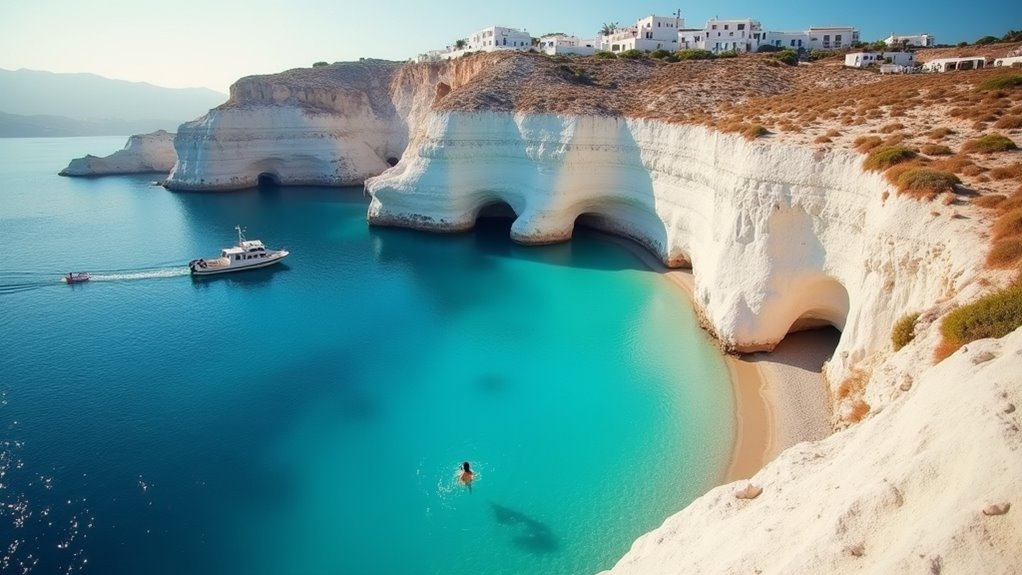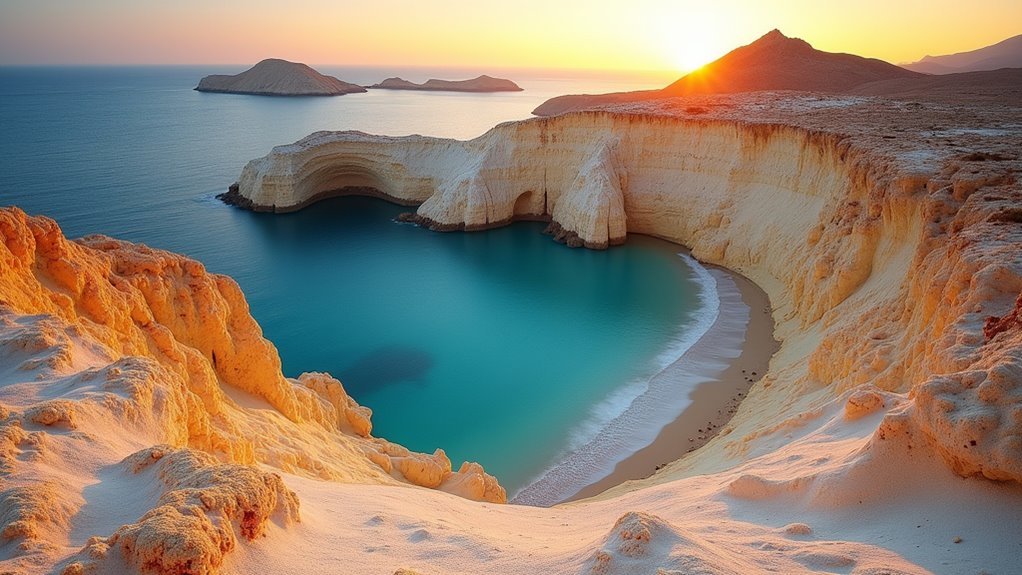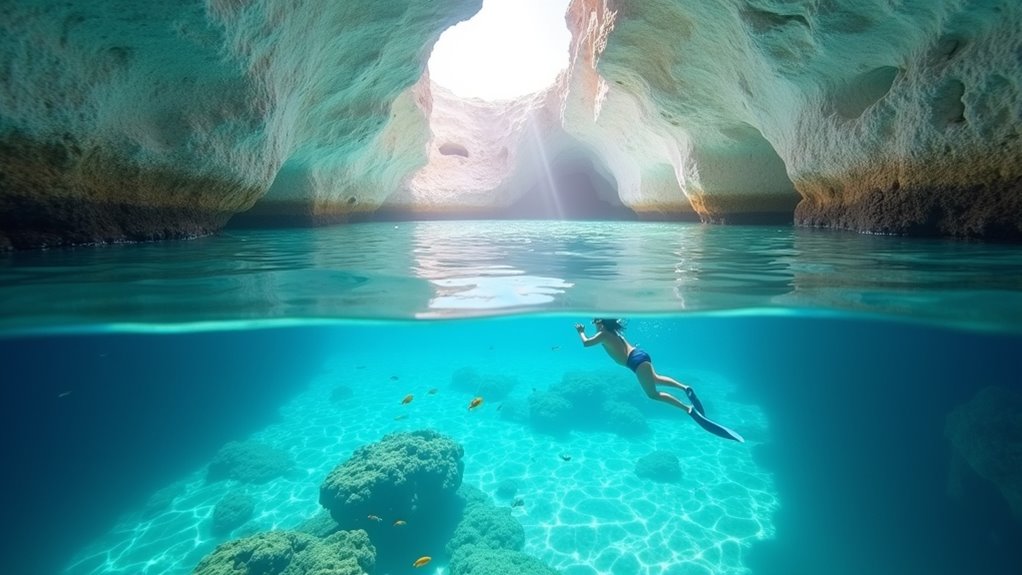Physical Address
304 North Cardinal St.
Dorchester Center, MA 02124
Physical Address
304 North Cardinal St.
Dorchester Center, MA 02124

If you're seeking Greece's best-kept secret, Milos delivers otherworldly landscapes and uncrowded beaches that Santorini visitors can only dream about.
You might not realize that Milos, a volcanic island in Greece’s Cyclades, remains largely undiscovered by mass tourism despite its stunning landscapes and abundant history. If you’re tired of fighting crowds at Santorini or Mykonos, this hidden gem offers the perfect alternative with its moon-like beaches, crystal waters, and archaeological treasures. The island where the Venus de Milo was discovered has maintained its authentic character while offering experiences that rival its more famous neighbors—but with far fewer travelers to share them with.

With its breathtaking landscapes and authentic Greek character, Milos offers a compelling alternative to more crowded Mediterranean destinations this summer. You’ll discover over 70 pristine beaches, from the ladder-accessible Tsigrado to emerald-water Papafragas nestled between towering cliffs.
The island’s geological wonders include the Kleftiko sea caves – former pirate hideouts now perfect for boat tours. Explore charming villages like Plaka with its sunset-viewing Kastro or Klima’s colorful syrmata houses built directly into the coastline. Milos continues to captivate visitors with its alluring landscape that seamlessly blends volcanic history with Mediterranean beauty.
History buffs will appreciate the ancient theater, extensive early Christian catacombs, and the discovery site of the famous Venus de Milo statue. Complete your experience with fresh seafood at waterfront tavernas and local wines while staying in renovated fishermen’s homes or boutique hotels. Don’t miss the opportunity to witness breathtaking sunsets from Utopia terrace in Plaka while enjoying evening cocktails and star gazing.
Among all of Milos’ natural wonders, Sarakiniko Beach rises above as the island’s most otherworldly attraction. This unique volcanic landscape features smooth, bone-white pumice formations sculpted by wind and waves into intricate patterns that resemble a lunar surface.
You’ll find minimal vegetation here, enhancing the desert-like moonscape that makes Sarakiniko one of the most photographed spots in the Aegean. The contrast between the white volcanic rock and the emerald sea creates a stunning backdrop for your summer adventures.
Dive from the cliff edges into crystal waters, explore the fascinating geological formations, or simply sunbathe on the smooth rock surfaces. This stunning location is about a 10-minute drive from Adamas port.
Much like Athens’ allure, Sarakiniko offers visitors a chance to experience something truly unique in Greece.
Don’t miss the wreck of “Africa,” which crashed here in 2003, adding another layer of intrigue to this already remarkable beach.

While Sarakiniko Beach draws crowds with its lunar-like appeal, Milos hides dozens of pristine coves and beaches that remain invigoratingly uncrowded even during peak season.
With over 70 unique beaches spread across 140km of coastline, you’ll discover incredible variety. Visit Kleftiko Bay’s dramatic white cliffs by boat or hike, or descend to Tsigrado Beach’s secluded cove with crystal waters. Kolympisionas Beach offers a private escape where visitors can enjoy skinny dipping and solitude away from the tourist crowds.
Paliochori and Paliorema showcase the island’s volcanic origins with vibrant colored rock formations.
For true seclusion, rent a car to reach accessible beaches or join sailing excursions to hidden coves inaccessible by land. Nearly everywhere you’ll find exceptionally clear turquoise waters perfect for swimming and snorkeling. Milos offers an authentic experience away from the crowds found on many of the Greek islands renowned for their beaches.
The island’s volcanic geology creates not just stunning beaches but hidden sea caves waiting for your exploration.
Beneath Milos’s stunning natural beauty lies an enchanting historical legacy that rivals its beaches in significance. You’ll discover Bronze Age settlements at Phylakopi, where Minoan and Mycenaean influences blend with Cycladic culture.
Don’t miss the ancient Dorian port of Klima with its Hellenistic and Roman ruins.
The island’s early Christian catacombs feature remarkable 1st-century frescoes, while the Archaeological Museum houses a plaster copy of the famous Venus de Milo alongside the Lady of Phylakopi figurine from 2000 BCE.
You can explore Milos’s affluent maritime past through guided tours of historical sites or join underwater expeditions to ancient shipwrecks. The island’s volcanic geology created abundant obsidian deposits that were traded extensively throughout the Mediterranean.
For adventure seekers wanting to combine history with natural wonders, Milos offers snorkeling experiences similar to those found in nearby Mykonos, allowing you to discover underwater treasures while enjoying crystal-clear waters.
Local conservation efforts have made these treasures accessible while protecting them for future generations, giving you a perfect balance of education and adventure.

Situated within the South Aegean Volcanic Arc, Milos showcases some of the Mediterranean’s most impressive geological wonders. This island’s entire landscape is fundamentally a volcanic caldera formed over 3 million years of activity.
You’ll be mesmerized by Sarakiniko Beach‘s otherworldly white pumice formations, where lunar-like terrain meets turquoise waters. As you explore the island, you’ll encounter diverse volcanic rocks including ash, tuff, and dramatic lava flows that have shaped this unique environment.
The island’s geological significance extends beyond tourism—it’s a valuable research site for volcanologists studying submarine volcanic complexes. The region’s dazzling colorful beaches like Fyriplaka, Fyropotamos, and Plathiena owe their striking appearance to post-volcanic alteration processes.
Unlike the larger Cretan geology, Milos offers visitors a more compact but equally fascinating showcase of Mediterranean volcanic features.
Hiking trails throughout Milos let you witness firsthand how volcanic forces have created a mineral-rich paradise that supports both unique ecosystems and a thriving mining industry.
Unlike its glamorous Cycladic siblings Santorini and Mykonos, Milos offers you a revitalizing authentic Greek island experience without battling crowds at every turn. With just 5,000 permanent residents, you’ll find a genuine slice of Greek life preserved in whitewashed villages and narrow winding lanes.
Wander through traditional Cycladic architecture draped with vibrant bougainvillea at your own pace. Savor local specialties at family-run tavernas like O Hamos where dishes emerge from volcanic ovens rather than tourist-oriented kitchens. Greece’s rich cultural heritage shines through in these authentic settings, giving you a deeper connection to this historic Mediterranean destination.
The island’s unhurried atmosphere lets you engage meaningfully with locals who’ll share insider knowledge about their home.
Visit during late April through September when the weather’s ideal and you’ll discover why travelers seeking authentic Greece are quietly choosing Milos over its overexposed neighbors. For the most pleasant experience with fewer crowds and more affordable accommodations, consider visiting during May’s shoulder season when you can enjoy sunny weather without the summer rush.

The transparent, azure waters surrounding Milos create an underwater paradise for snorkeling and diving enthusiasts. With visibility extending for meters, you’ll easily spot diverse marine life and unique volcanic formations beneath the surface.
Over 70 beaches offer varying experiences for water explorers. Sarakiniko’s white rock formations and Kleftiko’s secluded caves provide exceptional underwater scenery. The island’s volcanic origins contribute to the fascinating underwater landscapes that make each dive site unique. If you’re a beginner, head to Adamantas or Pollonia Beach where shallow, calm waters make learning safe and enjoyable.
Several dive centers across the island offer equipment rentals, instruction, and guided tours to the best spots. You don’t need to worry about accessibility either—many prime snorkeling locations can be reached by land, while boat tours take you to more remote sites worth discovering. Much like family-friendly Zakynthos, Milos provides safe and clear waters for swimmers of all ages and experience levels.
You’ll spend hours researching “undiscovered” Greek islands, only to find Milos was right there all along. Isn’t it ironic? While others crowd onto Santorini’s sunset spots, you’ll have Sarakiniko’s moon-like shores nearly to yourself. Don’t overthink it—Milos delivers authentic Greece without the Instagram queues. Pack light, book now, save the regrets for those who chose elsewhere.